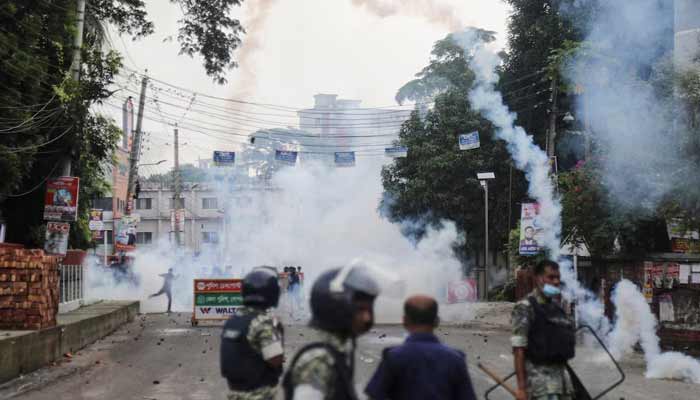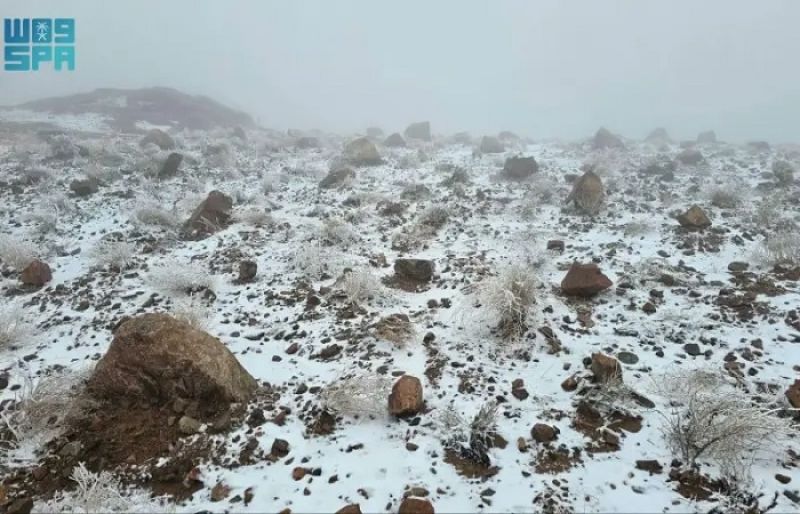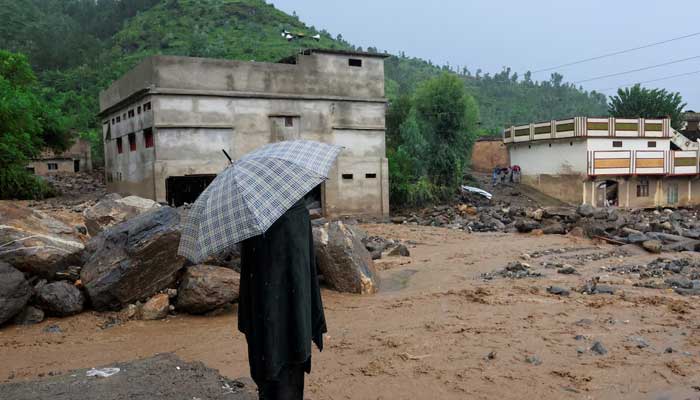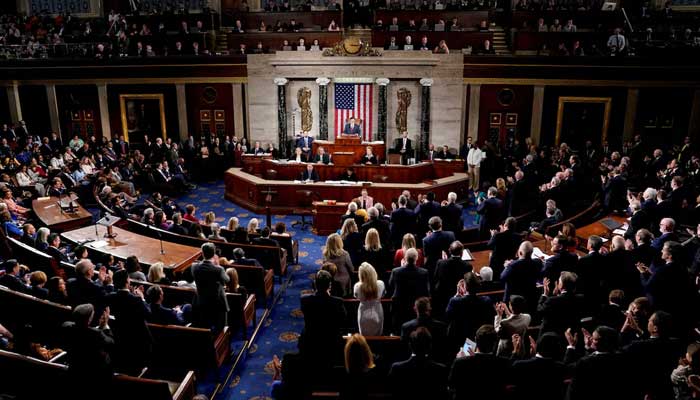Politics
Political violence kills almost 300 since Hasina’s fall: rights group


Nearly 300 people have been killed in political violence in Bangladesh in the year since student-led protests toppled autocratic former leader Sheikh Hasina, the country’s main human rights group said on Sunday.
A report by Odhikar, a Dhaka-based rights organisation, said at least 281 people had been killed in violence involving political parties from August 2024, when Hasina’s rule ended and she fled to India, to September 2025.
On top of those, there were another 40 victims of extrajudicial killings who had been suspected of crimes, while another 153 were lynched, the quarterly report released last week said.
Odhikar director ASM Nasiruddin Elan said adherence to human rights had improved since the fall of Hasina’s government but law enforcement agencies were still not being held accountable.
“Yes, we don’t see the frequent extrajudicial killings or enforced disappearances that we witnessed during the Hasina era, but deaths in custody, bribery, and harassment of victims are still ongoing,” Elan told AFP.
He said that “innocent people fall prey to atrocities” for their alleged involvement with the Awami League, Hasina’s political party that is now banned.
Hasina’s 15-year rule saw widespread human rights abuses, including the mass detention and extrajudicial killing of her political opponents.
Odhikar also said mob attacks had been relatively frequent during the period, mainly because of inefficient policing.
“Police have been used to achieve party interests and were given impunity, which eventually led them to kill and torture activists affiliated with the opposition,” the report said.
It said “the police largely became dysfunctional and lost their morale”, after Hasina fell.
Bangladesh’s interim government nor any of the political parties have responded yet to Odhikar’s report.
Politics
Australia’s Head slams unbeaten 142 to crush England’s Ashes hopes


Danger man Travis Head crunched his fourth century in as many Tests at Adelaide Oval Friday as Australia built a 356-run lead over England to stand on the brink of retaining the Ashes.
The hosts were 271-4 at stumps on day three of the third Test with Head on 142 and first-innings century-maker Alex Carey not out 52, taking the five-match series out of England’s reach.
England must win after crashing inside two days at the first Test in Perth and inside four in Brisbane, both by eight wickets.
But it appears to be an impossible task with the highest run chase at the ground 316 by Australia against England in 1902.
Head’s crucial ton, his 11th, came off a composed 146 balls although he almost didn’t get there, dropped on 99 by Harry Brook as impatience got the better of him.
He has now scored a century in four consecutive Tests on his home ground, following 140 against India last year and 119 and 175 against the West Indies.
Australia suffered an early setback in a tense 20 minutes before lunch after England were all out for 286 on the back of Ben Stokes’ gritty 83 in response to Australia’s first innings 371.
Bryson Carse trapped Jake Weatherald lbw for one and he walked without reviewing after the umpire lifted his finger, although replays showed the ball was pitching outside leg stump.
It gave England a glimmer of hope, but after the break Head slammed the door shut, cutting and chopping boundaries to all corners of the ground.
Marnus Labuschagne went for 13 when he edged Josh Tongue to Harry Brook at slip, with reviews showing it carried.
Usman Khawaja, who hit a defiant 82 in the first innings after his last-minute call-up for the ill Steve Smith, was a perfect foil for the more aggressive Head.
But on 40 he was undone by the spin of Will Jacks, caught behind, and Cameron Green followed soon after for seven, edging Tongue to Brook.
After getting through the nervous 90s, Head finally brought up his century with a four off Joe Root, taking off his helmet and kissing the turf before pumping his fists.
While not in the same vein as his match-winning 69-ball century in Perth, it was a critical knock, supported by Carey and aided by Stokes not bowling after his exploits with the bat.
Gutsy Stokes
After a woeful batting display on Thursday, Stokes and Jofra Archer kept England’s dreams alive with a stirring 106-run ninth-wicket stand.
They resumed at 213-8 in muggy conditions with Stokes not out 45 and Archer on 30.
Stokes, who suffered leg cramps and dehydration during his gutsy rearguard action in sweltering 40 Celsius heat on Thursday, brought up his slowest ever 50 in Tests, off 159 balls.
England’s Ben Stokes (L) and Jofra Archer run between the wickets on the third day of the third Ashes cricket Test match between Australia and England at the Adelaide Oval in Adelaide on December 19, 2025. — AFP
He kept plugging away but finally fell when Mitchell Starc took the new ball and bowled him, with Stokes one of the few players who showed the fight he had demanded before the game.
Archer was another, ably helping his captain.
The fast bowler was the last man out when caught by Labuschagne off Scott Boland for 51 — his highest Test score and a maiden half-century Boland ended with 3-45 while Pat Cummins took 3-69 in his first Test since July.
England’s woes began when openers Zak Crawley and Ben Duckett, along with the under-performing Ollie Pope, departed in a 15-ball blitz on Thursday at the hands of Cummins and Nathan Lyon.
Harry Brook showed some resistance with 45, but the Australian attack was relentless.
Politics
Saudi Arabia, Qatar have a white winter as snowfall hits northern areas


According to Khaleej Times, a period of low-pressure systems in the Middle East has brought heavy rainfall over the last week. Conditions were forecast to intensify on Thursday, with thunderstorms expected to hit the region.
The storm was then forecast to move eastwards towards the UAE and Qatar by night, it added, citing BBC Weather.
Khaleej Times reported that large areas of Qatar had also been covered by snowfall already, sharing a video of the landscape.
In Saudi Arabia, snow and light rainfall were experienced in Trojena, a mountain destination for hiking and skiing located on Jebel Al-Lawz in the province of Tabuk that reaches up to 2,600 metres, according to Arab News.
Additionally, light to moderate rain was experienced in Bir Bin Hermas, Al-Ayinah, Ammar, Al-Ula Governorate and Shaqra and its suburbs. Several other regions, including Riyadh, also experienced moderate to heavy rainfall, the outlet added.
Riyadh experienced thick cloud cover and rainfall from early yesterday. According to Arab News, all schools in the Saudi capital switched to remote learning amid the continuing inclement weather.
“The Qassim Region, including the city of Buraidah, experienced moderate to heavy rainfall, while Tabuk Region experienced light to moderate rainfall on Thursday,” it said, citing the Saudi Press Agency (SPA).
“Parts of Hail region also witnessed snowfall on Wednesday evening in areas surrounding the city of Hail, while light to moderate rainfall was reported across the region and several of its governorates.”
The outlet added that according to the SPA, the National Centre for Meteorology (NCM) anticipated more snow in the northern parts of the Riyadh region and the governorates of Al-Majmaah and Al-Ghat, north of Riyadh, which witnessed snowfall on Thursday morning that led to accumulations over highland and open areas.
The official spokesperson for the NCM, Hussein Al-Qahtani, explained that the weather conditions affecting the north of the region were caused by a cold mass of air advancing into the area, accompanied by rain-bearing clouds. This contributed to temperatures dropping below zero degrees Celsius in some locations.
“Al-Qahtani noted that the centre had issued early warnings regarding the weather conditions, adding that specialised teams continued to monitor developments,” Arab News said, adding that the spokesperson expected temperatures to remain low over the coming hours with a chance of frost in several northern and central areas.
He urged citizens and residents to exercise caution, particularly while driving on exposed roads, due to the potential formation of ice.
“He also stressed the importance of following official weather updates issued by the centre through its official channels, while adhering to preventive guidelines and avoiding open areas during peak cold periods to ensure public safety,” the agency said.
Reactions to unprecedented snowfall
Many people gathered to witness the snowfall in Al-Majmaah and Al-Ghat.
Thamr Alotaibi, a Riyadh resident, told Arab News, “This is unprecedented, so we are excited to see it. Me and my friends are going to experience this winter wonder which is going to be an amazing experience.”
Meanwhile, due to gusty and dust-stirring winds, the General Directorate of Civil Defence called for caution and adherence to guidelines in light of the inclement weather conditions.
“It has advised residents to avoid going to valleys during this spell of weather,” the outlet said.
Riyadh resident Abdul Hammed told Arab News: “We had an outing planned for a family get-together at a banquet on the city’s outskirts but the prevailing weather has forced us to change the plan, and we have decided to remain indoors instead.”
Experts say snowfall not unusual
Against this backdrop, a leading Saudi astronomer said such snowfall events are not unusual during the winter months, Gulf News reported.
Mohammed bin Reddah Al Thaqafi, an astronomer and expert at the Taif Astronomical Sundial and a member of the Arab Union for Space and Astronomy Sciences, said that snowfall in northern Saudi Arabia occurs periodically each winter, even though it does not follow a fixed astronomical cycle.
Its recurrence depends largely on shifting climatic and atmospheric conditions, he explained, according to the agency.
He added that snowfall was typically recorded between December and February and was most common in regions such as Tabuk, Al-Jouf and Arar, which are more exposed to Mediterranean weather systems than other parts of the kingdom.
“He identified areas including Jabal Al Lawz, Alaqan and Al Dhahr in Tabuk; Sakaka and Dumat Al Jandal in Al Jouf; Arar in the Northern Borders; Jabal Aja and Jabal Salma in Hail; and the highlands of Abha in Asir as the locations most likely to experience snowfall,” Gulf News said.
While some seasons pass without snow, the expert noted that these areas remain among the most reliable destinations for winter conditions, the agency added.
Al Thaqafi urged motorists and outdoor visitors to exercise caution in the snow, warning of slippery roads and reduced visibility, and stressed the importance of adhering to traffic regulations to avoid accidents, it said.
Politics
Five things to keep an eye on in 2026


PARIS: Next year promises trips around the Moon, footballing spectacles and a battle for control of the US Congress.
Here are five big events to watch out for in 2026.
Climate: Will the world act?
The world is already experiencing record heat — and things are likely to get hotter in 2026.
Last year was the warmest on record, but the UN says there is an 80% chance that at least one year will be even hotter by 2029.
How will nations react? COP30 in Brazil recently showed that multilateralism in climate action is not dead, despite the US boycott and geopolitical conflicts.
“2026 must be the year in which international climate diplomacy reinvents itself,” said Rebecca Thissen, from Climate Action Network.

“COPs are not an end in themselves but a high point in an international political agenda that desperately needs to get on the same page,” she added.
A close eye will be kept on how many countries respond to Colombia´s invitation to the first international conference on phasing out fossil fuels in April.
Aleksandar Rankovic, director of The Common Initiative think tank, was disappointed by COP30’s outcome and wondered if the “Gen Z-led rebellions that have emerged worldwide will start fighting for climate as well” in 2026.
Biggest football World Cup
The biggest World Cup in history will see 48 countries competing in the United States, Canada and Mexico, under the gaze of President Donald Trump.
The most-watched sports event in the world will unfold over nearly six weeks, from June 11 to July 19, with the US providing 11 of the 16 venues.
US President Donald Trump’s tensions with the co-hosts over tariffs and immigration could make for a politically charged competition.
On the pitch, a richly talented French squad led by Kylian Mbappe will be determined to make up for their defeat to Lionel Messi’s Argentina in the 2022 final in Qatar, but Spain also have high hopes.

Cristiano Ronaldo, who will be 41 when the tournament kicks off, has said his sixth World Cup will be his last, and he would dearly like to crown his career with a first global title for Portugal.
Cape Verde, Uzbekistan and the tiny island nation of Curacao are among the countries appearing for the first time.
Fans could face eye-watering costs for the most popular games due to Fifa’s use of dynamic ticket pricing.
Gaza, Israel, Netanyahu’s future
US pressure led to a ceasefire between Israel and Hamas that came into force on October 10, after two years of war.
The truce is proving highly fragile, and Trump’s peace plan for the Gaza Strip leaves many points unresolved, such as future stages of the Israeli army’s withdrawal, reconstruction of the Palestinian territory and its future governance.
By formally endorsing Trump´s plan, the UN Security Council laid the groundwork for the deployment of an international force in Gaza that, fundamentally, neither Israel nor Hamas wants.
The Palestinian group refuses to disarm under the conditions set by Israeli Prime Minister Benjamin Netanyahu, who is threatening to resume fighting if the Gaza Strip cannot be demilitarised through diplomacy.

Now 76, Netanyahu intends to run again in the elections due to be held no later than November 2026.
His multi-party coalition, which now holds just 60 of 120 seats in parliament, remains fragile.
A broad majority of Israelis want to see Netanyahu held accountable for the failures that led to the October 7, 2023 attack that sparked the war in Gaza.
A relative majority also oppose him receiving the presidential pardon he requested at the end of November in a bid to rid himself of his long-running corruption trials.
Netanyahu might therefore be tempted to pursue the military option against Hamas in Gaza or Hezbollah in Lebanon to keep his far-right allies on board, and secure the total victory he has promised Israelis.
Control of US Congress
As voters brace for the 2026 US midterm elections, the stakes could hardly be higher — for Trump, Congress and the nation.
Trump isn’t on the ballot, but a strong Republican showing would validate his authority beyond the White House.
But if his favoured candidates fail to perform, it could expose cracks in his movement and complicate any succession plan.
Republican control of Congress, meanwhile, is hanging by a thread.
Razor-thin majorities in the House of Representatives and Senate hinge on defending constituencies with vulnerable incumbents in battlegrounds like Michigan, North Carolina and Ohio.

With no checkbox marked “Trump” on the ballot, the president is having to pull out all the stops to make sure his supporters turn out en masse.
Democrats see and opportunity, especially as the party of the incumbent typically loses seats in midterms.
Forecasts suggest Republicans could struggle to hold the House, and Democrats are also targeting four Senate seats needed to take control.
While full Republican control would let Trump cement his legacy, Democratic control in either chamber would slow his agenda and likely entangle his administration in investigations.
Astronauts around the Moon
Politicians and enthusiasts dream of the day when people will walk on the Moon again.
Although it’s unlikely to happen next year, Nasa is planning a crewed mission to fly around the Earth’s satellite — the much-delayed Artemis II is scheduled for lift-off by April at the latest.
It would be a huge step towards Americans once again setting foot on the lunar surface, a goal announced by Trump in his first term.

China aims to land on the Moon by 2030 and is also making progress.
Its Chang’e 7 mission is expected to be launched in 2026 for an exploration of the Moon’s south pole, and testing of its crewed spacecraft Mengzhou is also set to go ahead next year.
India, which landed a robot on the Moon in 2023, is another country with emerging space exploration ambitions, planning to send an astronaut into orbit in 2027.
-

 Business6 days ago
Business6 days agoHitting The ‘High Notes’ In Ties: Nepal Set To Lift Ban On Indian Bills Above ₹100
-

 Politics1 week ago
Politics1 week agoTrump launches gold card programme for expedited visas with a $1m price tag
-

 Business1 week ago
Business1 week agoRivian turns to AI, autonomy to woo investors as EV sales stall
-

 Fashion1 week ago
Fashion1 week agoTommy Hilfiger appoints Sergio Pérez as global menswear ambassador
-

 Sports1 week ago
Sports1 week agoPolice detain Michigan head football coach Sherrone Moore after firing, salacious details emerge: report
-

 Business1 week ago
Business1 week agoCoca-Cola taps COO Henrique Braun to replace James Quincey as CEO in 2026
-

 Sports1 week ago
Sports1 week agoU.S. House passes bill to combat stadium drones
-

 Tech1 week ago
Tech1 week agoGoogle DeepMind partners with UK government to deliver AI | Computer Weekly






